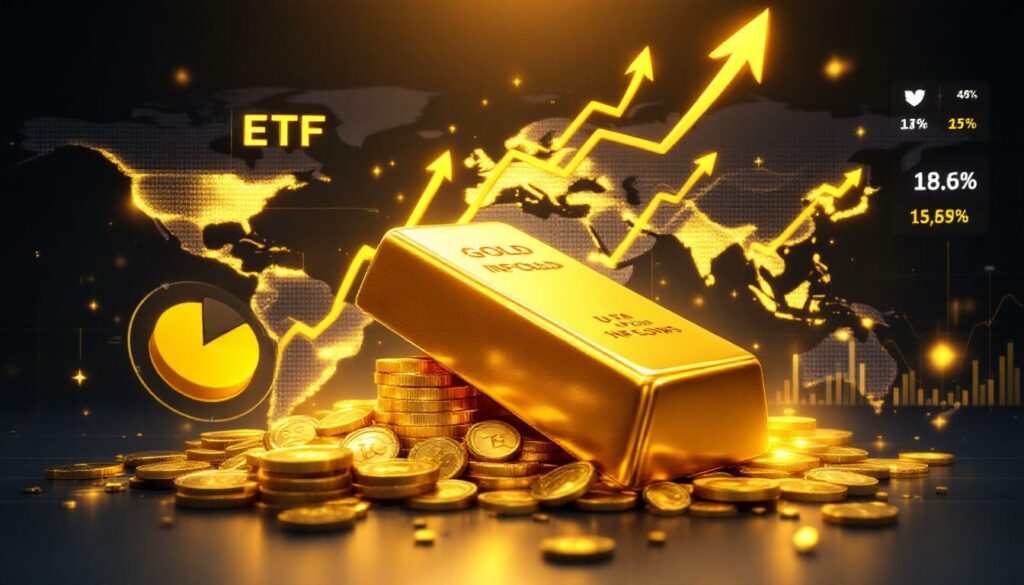What Are Gold ETFs and Why Are They Seeing Record Inflows?
Gold exchange-traded funds (ETFs) represent one of the most accessible ways for investors to gain exposure to gold without physically owning the precious metal. These investment vehicles track gold prices while trading on stock exchanges like ordinary shares, combining the benefits of gold investment with the convenience of stock trading.
The first half of 2025 has seen unprecedented interest in gold ETFs, with the World Gold Council (WGC) reporting a substantial $38 billion inflow between January and June—marking the largest semi-annual inflow since H1 2020. This dramatic surge comes after three consecutive years of outflows (2021-2023) followed by modest net inflows in 2024.
"A trade war sparked by US President Donald Trump's tariff policy prompted investors to seek shelter from political and economic volatility in gold ETFs, which account for a major part of investment demand for the precious metal," according to World Gold Council data released in July 2025.
This reversal represents a fundamental shift in investor sentiment, as market participants increasingly view gold as a safe-haven during periods of heightened uncertainty. The scale of these inflows demonstrates gold's enduring appeal as a strategic asset, particularly when geopolitical and economic landscapes become unstable.
How Do Gold ETFs Work?
Physical Backing Mechanism
Gold ETFs maintain their value through a straightforward but robust structure: each share is backed by physical gold stored in secure vaults by custodian banks. When investors purchase shares, the fund uses that capital to buy additional gold, ensuring the ETF's value moves in parallel with gold prices.
Most physical gold ETFs hold London Good Delivery bars (approximately 400 troy ounces each) in specialized vaults subject to regular audits. This physical backing distinguishes gold ETFs from other commodity-based financial instruments that merely track price movements through derivatives.
The trust structure typically allows authorized participants (usually large financial institutions) to create or redeem large blocks of shares (called "creation units") by either depositing gold or receiving gold in exchange for shares. This mechanism helps maintain the ETF's price alignment with the underlying gold value.
Trading and Accessibility Features
Unlike physical gold, ETF shares offer exceptional liquidity, trading throughout market hours with tight bid-ask spreads. Investors can execute trades instantly through standard brokerage accounts without the logistical challenges of physical delivery or storage.
The minimal investment threshold—often just the price of a single share—makes gold ETFs remarkably accessible compared to gold bullion, which typically requires purchasing full ounces. Most gold ETFs also feature competitive expense ratios between 0.25% and 0.40% annually, significantly lower than many gold mutual funds that may charge 1% or more.
For tax purposes, most jurisdictions treat gold ETFs more favorably than physical gold holdings, often applying standard capital gains rates rather than the higher collectibles tax rate that might apply to physical precious metals.
Why Are Gold ETFs Experiencing Record Inflows in 2025?
Economic and Political Catalysts
The unprecedented $38 billion flowing into gold ETFs during H1 2025 stems primarily from escalating global trade tensions. Market data reveals that trade disputes—particularly those triggered by new U.S. tariff policies—have created substantial volatility across equity and currency markets, driving investors toward traditional safe-haven assets.
This geopolitical uncertainty has coincided with persistent inflation concerns in major economies, creating a perfect storm for gold demand. The precious metal has historically performed well during periods of both economic instability and inflationary pressures, making gold as inflation hedge an attractive option for portfolio protection.
Breaking the Outflow Cycle
The current influx represents a dramatic reversal after three consecutive years of outflows from 2021-2023. During that period, rising interest rates diminished gold's relative appeal, as higher yields on fixed-income investments reduced the opportunity cost of holding non-yielding assets like gold.
"The active first half of the year follows a modest net inflow to gold ETFs in 2024 after three years of outflows caused by high interest rates," notes the World Gold Council in their latest report.
This shift demonstrates gold's cyclical nature as an investment asset, with demand often correlating inversely with real interest rates and directly with economic uncertainty. The 2025 inflows suggest that market concerns about global trade and economic stability now outweigh interest rate considerations for many investors.
What Are the Current Gold ETF Holdings?
Global Holdings Analysis
As of June 2025, collective gold ETF holdings stand at 3,615.9 metric tons—the highest level since August 2022. This represents a substantial increase of 397.1 tons during the first half of the year alone, reflecting the massive capital inflows into these investment vehicles.
For historical context, the all-time record for gold ETF holdings remains at 3,915 tons, established in October 2020 during the height of pandemic-related economic uncertainty. Current holdings are approaching this record level, sitting just 299.1 tons below the historic peak.
This trajectory suggests that if current inflow trends continue through the second half of 2025, total ETF gold holdings could potentially surpass the previous record by year-end, potentially pushing all-time high gold prices even higher.
Regional Distribution of Inflows
The geographic distribution of these inflows reveals interesting patterns about regional investor sentiment:
| Region | H1 2025 Inflows (tons) | % of Global Inflows | % of Global AUM |
|---|---|---|---|
| U.S. | 206.8 | 52% | ~70% |
| Asia | 104.3 | 28% | 9% |
| Europe | 85.9* | 20%* | ~20%* |
*Estimated based on available data
U.S.-listed funds led global inflows with 206.8 tons in the first half of 2025, accounting for approximately 52% of global additions. This dominance reflects both the size of the American investment market and heightened concerns about domestic economic conditions.
"Despite slowing momentum in May and June, Asian investors bought a record amount of gold ETFs during the first half of the year, contributing an impressive 28% to net global flows with only 9% of the world's total assets under management," the WGC noted in their report.
This disproportionate impact from Asian markets—contributing nearly three times their global AUM percentage to new flows—highlights the rapidly growing importance of Asian investors in the gold market, particularly those in China and India where cultural affinity for gold remains strong.
How Has Gold Price Performance Influenced ETF Trends?
Price Appreciation and Record Levels
Gold's price performance has been nothing short of remarkable in 2025, with spot prices surging 26% since January and reaching an unprecedented $3,500 per ounce in April. This steep appreciation has both driven and been supported by the strong ETF inflows, creating a self-reinforcing cycle.
The price trajectory has exceeded most analyst forecasts from late 2024, which typically projected more modest gains in the $2,800-3,000 range. This outperformance has attracted additional investor interest, particularly from momentum-driven market participants who may have previously overlooked gold as an investment option.
According to the World Gold Council's ETF data, the correlation between price movements and ETF flows has been particularly strong in U.S. markets, where weekly inflow data shows accelerated purchasing activity during periods of rapid price appreciation.
Momentum Patterns
While the first quarter of 2025 showed consistent acceleration in ETF inflows, May and June exhibited some moderating momentum. This pattern was most pronounced in Asian markets, where record early-year buying gave way to more selective investment approaches as prices stabilized near all-time highs.
This moderation doesn't necessarily indicate waning interest but rather a more measured approach to asset allocation as investors digest the substantial price gains already achieved. The WGC's analysis suggests this represents a normal consolidation phase rather than the beginning of a reversal in sentiment.
Price volatility metrics remain relatively low compared to historical gold bull markets, suggesting current holders remain confident in their positions despite the modest inflow deceleration observed in the late second quarter.
What Role Do Central Banks Play in the Gold Market?
De-Dollarization Trends
Central banks globally continue to accumulate gold reserves as part of diversification strategies away from dollar-denominated assets. A recent WGC survey indicates this trend is likely to continue, with many central banks citing "de-dollarization" as a motivating factor for increasing gold holdings.
This shift represents a multi-year strategic reallocation by central banks across various regions, with particular emphasis from nations seeking to reduce dependence on the U.S. dollar as a reserve currency. The process has accelerated in response to geopolitical tensions and concerns about potential sanctions that could restrict access to dollar-based payment systems.
The WGC survey found that approximately 70% of central banks plan to increase their gold reserves over the next 12-24 months, citing portfolio diversification, long-term value preservation, and reduced reliance on specific currencies as primary motivations.
Impact on Overall Gold Demand
Central bank purchasing creates significant additional demand pressure in the gold market, complementing the retail and institutional investment flows through ETFs. This multi-source demand has contributed substantially to price strength and gold market surge that analysts are tracking closely.
Unlike ETF investment, which can exhibit higher volatility based on market sentiment, central bank gold acquisition tends to follow longer-term strategic plans, providing a more stable baseline demand. This stability helps support price floors during market corrections and reinforces investor confidence in gold's long-term value proposition.
The combination of central bank purchases and ETF inflows represents a powerful demand dynamic that market analysts believe could support gold prices through potential market turbulence in the coming quarters.
How Do Gold ETFs Compare to Other Gold Investment Options?
ETFs vs. Physical Gold
While physical gold offers direct ownership without counterparty risk, ETFs provide significant advantages in liquidity, storage costs, and divisibility. ETF investors avoid concerns about authenticity, security, and insurance that come with physical ownership.
The cost comparison between these options reveals important differences:
| Aspect | Gold ETFs | Physical Gold |
|---|---|---|
| Storage Costs | Built into expense ratio (0.25-0.40% annually) | Typically 0.5-1.5% annually for secure storage |
| Insurance | Included in expense ratio | Additional cost for owners |
| Liquidity | Instant during market hours | May require dealer/buyer (1-3 days) |
| Minimum Investment | Single share (~$200-350) | Full ounce (~$3,500) or fractional with premium |
| Authentication | Not required | Necessary for resale |
For investors primarily concerned with tracking gold price movements rather than owning the physical metal, ETFs typically offer a more cost-effective and convenient solution, particularly for allocations below $100,000.
ETFs vs. Gold Mining Stocks
Gold mining stocks offer operational leverage to gold prices but come with company-specific risks including management decisions, production costs, and geopolitical exposure. ETFs provide pure exposure to gold price movements without these additional variables.
Mining companies generally amplify gold price movements—often rising or falling 2-3 times faster than the metal itself—due to their operational leverage. While this can enhance returns during bull markets, it also magnifies losses during downturns.
ETFs maintain consistent correlation with gold prices regardless of market direction, making them more predictable and often more suitable for investors seeking precise allocation to gold as an asset class rather than speculating on individual companies' operational performance.
What Is the Outlook for Gold ETFs in the Second Half of 2025?
Key Factors to Watch
Several critical factors will likely influence gold ETF flows in the coming months:
-
Interest rate trajectory: Any shift in central bank monetary policy, particularly by the Federal Reserve, could significantly impact gold's relative attractiveness. Rate cuts typically benefit gold by reducing the opportunity cost of holding non-yielding assets.
-
Inflation trends: Persistent inflation above central bank targets would likely support continued gold demand as a purchasing power preservation tool. Current indicators suggest inflation remains above target in several major economies.
-
Geopolitical developments: The evolution of trade tensions, particularly between the U.S. and China, will likely remain a key driver of safe-haven demand. Any escalation could accelerate ETF inflows, while de-escalation might moderate demand.
-
Currency market volatility: Significant movements in the U.S. dollar index have historically shown inverse correlation with gold prices. A weakening dollar typically supports higher gold prices and increased ETF demand.
Potential Scenarios
If trade tensions and economic uncertainty persist, gold ETFs may continue attracting defensive capital. Analysts project potential additional inflows of $25-35 billion in the second half, which could push total holdings beyond the 3,915-ton record established in 2020.
However, any significant economic stabilization or resolution of trade disputes could moderate inflows or potentially trigger profit-taking. This scenario would likely result in more modest growth or even temporary outflows as investors reallocate toward risk assets.
The technical picture suggests strong support around the $3,200 level, with resistance at $3,600-3,700. Breaking through these levels could trigger additional momentum-driven flows in either direction as outlined in various gold price forecast 2025 analyses.
FAQs About Gold ETFs and Investment
Are gold ETFs a good investment during periods of inflation?
Gold has historically performed well during inflationary periods, making gold ETFs a potential hedge against purchasing power erosion. Analysis of gold's performance during the five highest inflation years since 1970 shows an average annual return of 14.9%, outpacing inflation in four of those five years.
However, performance can vary based on real interest rates (nominal rates minus inflation). Gold typically performs best when real rates are negative or falling, as the opportunity cost of holding non-yielding assets decreases under these conditions.
Investors should consider that gold's inflation-hedging benefits often manifest over longer timeframes (3-5 years) rather than responding to short-term inflation fluctuations.
How do gold ETF taxes work?
In most jurisdictions, gold ETFs are taxed differently than physical gold. While physical gold may be subject to collectible tax rates (often higher than standard capital gains), many gold ETFs are taxed at standard capital gains rates, potentially offering tax advantages for investors.
In the United States, for example:
- Physical gold held less than one year: Ordinary income tax rates
- Physical gold held more than one year: Collectible tax rate (maximum 28%)
- Many gold ETFs held more than one year: Long-term capital gains rates (0%, 15%, or 20% depending on income bracket)
However, tax treatment varies by jurisdiction and specific ETF structure. Some gold ETFs organized as grantor trusts may still be taxed as collectibles, so investors should consult prospectuses and tax advisors for specific guidance.
Can gold ETFs be included in retirement accounts?
Unlike physical gold, which has restrictions in many retirement accounts, gold ETFs can typically be included in IRAs and other retirement vehicles, offering tax-advantaged exposure to gold price movements.
Most major brokerages allow gold ETF investments within traditional and Roth IRAs, 401(k)s (where investment options permit), and other qualified retirement accounts. This accessibility represents a significant advantage over physical gold, which requires a specialized self-directed IRA with a custodian capable of handling physical precious metals, often incurring higher fees.
When selecting gold ETFs for retirement accounts, investors should consider expense ratios, trading volumes, and tracking accuracy to maximize long-term performance within these tax-advantaged vehicles.
What happens to gold ETF shares during market disruptions?
During severe market disruptions, gold ETF shares may temporarily trade at premiums or discounts to their net asset value. However, the creation/redemption mechanism typically corrects these disparities relatively quickly as authorized participants arbitrage the difference.
Historical analysis of major market stress events (2008 financial crisis, 2020 COVID market crash) shows that while gold ETFs occasionally experienced 1-2% premiums or discounts during extreme volatility, these deviations typically normalized within 1-3 trading days.
This self-correcting mechanism provides an important stability advantage compared to closed-end funds, which can trade at persistent discounts or premiums without a similar arbitrage opportunity.
Further Exploration:
Readers interested in learning more about gold ETF trends can also explore related educational content, such as the World Gold Council's regular market analyses and reports on global gold investment trends.
Looking to Gain an Edge in ASX Gold Discoveries?
Discovery Alert's proprietary Discovery IQ model provides instant notifications when significant gold discoveries are announced on the ASX, helping investors capitalise on opportunities before the broader market. Explore how major mineral discoveries have generated substantial returns by visiting our dedicated discoveries page and start your 30-day free trial today.




